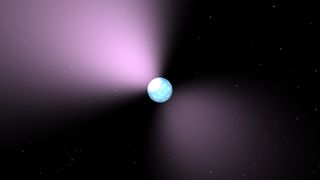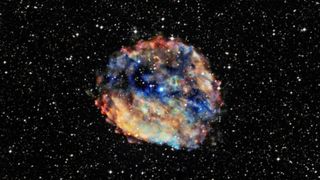What are pulsars?
These ultra-dense remnants of massive stars emit beams of radiation like a lighthouse.

A pulsar is a special kind of neutron star, which is the ultra-dense leftover core of a massive star.
Pulsars emit beams of radiation that sweep out in circles as the pulsar spins. When those beams flash over Earth, we see them as regular, repeating pulses of radio emission.
“Pulsars are spectacular objects themselves — the mass of the Sun crammed into a tiny ball the size of a city, spinning on its axis, in some cases faster than a kitchen blender, and sweeping beams of radio waves across the sky,” Anne Archibald, a professor of astronomy at Newcastle University in the U.K., told Live Science in an email.
Who discovered pulsars?
In 1967 a graduate student named Jocelyn Bell was studying results from the Interplanetary Scintillation Array at the Mullard Radio Astronomy Observatory in Cambridge, U.K. She was working with her advisor, Antony Hewish, when they found a source of repeating radio signals coming from the same place in the sky every night, according to the CSIRO Australian Telescope National Facility.
The signal was so regular, repeating every 1.33 seconds, that Bell and Hewish wondered if they had stumbled across a message from an advanced alien civilization. They even initially called the source “LGM-1” for “little green men.” But once they found other similar sources in other parts of the sky, they knew the signals had to have a natural origin (otherwise the aliens would be everywhere).
Although pulsars emit in all wavelengths of electromagnetic radiation, radio waves are the best at penetrating clouds of interstellar gas and dust in a galaxy, and so astronomers tend to see distant objects in the radio spectrum before other parts of the spectrum.
How are pulsars formed?

Prior to the discovery of pulsars, astronomers had already theorized that neutron stars might exist. They worked out that when a star that’s much more massive than the sun dies, it can sometimes leave behind an incredibly dense core. Astronomers called that core a neutron star. A neutron star has incredibly high density (about the same density as an atomic nucleus), putting several suns’ worth of material into a volume only a few miles across, according to the National Science Foundation’s National Radio Astronomy Observatory.
While neutron stars are made almost entirely of neutrons, they do contain some positively charged protons. Because neutron stars are so small and dense, they rotate incredibly quickly. The charges moving in a circle power up incredibly strong magnetic fields, and that magnetism can launch beams of radiation that shoot out of the neutron star’s magnetic poles.
How do pulsars pulse?
The magnetic poles of a neutron star rarely line up with its spin axis. This is just like Earth: Our planet's magnetic poles do not align with its geographic poles. On neutron stars, this causes the beam of radiation to sweep across space in circles above and below the star, according to NASA’s Imagine the Universe.
If the beams of radiation miss Earth, astronomers will see a normal neutron star. But if the beam sweeps over Earth, telescopes here will detect a burst of radiation every time the beam circles back around. From an Earthling's perspective, these look like regular flashes or pulses of radiation, hence the name "pulsars."
The flashes from pulsars are extremely regular, with some maintaining regular cycles to within a billionth of a nanosecond.
"It's like having a precision clock conveniently installed somewhere in the galaxy," Archibald said.
Are pulsars dangerous?

From far away, pulsars are no more dangerous than any other exotic kind of star in the universe. However, getting up close and personal with a pulsar would be a bad idea. In addition to the beams of radiation, pulsars typically have very strong magnetic fields, and the neutron stars themselves are often hot enough to emit X-ray radiation.
Thankfully, the nearest known pulsar, PSR J0108-1431, is safely 424 light-years away.
How many pulsars are there?
Even though astronomers believe that there are about a billion neutron stars in the Milky Way galaxy, we know of only about 2,000 pulsars. Part of the reason for this discrepancy is that the radiation beam of a pulsar has to line up perfectly with Earth for telescopes here to see it. Second, not every neutron star is spinning fast enough or has a strong enough magnetic field to generate beams of radiation. Lastly, astronomers have only mapped a small fraction of the total volume of the galaxy, and they have not observed every pulsar, according to NASA.
Why do pulsars slow down?
Through careful observations, astronomers have found that pulsars tend to slow down with time. Emitting strong beams of radiation takes energy, and that energy comes from the rotational energy of the neutron star. As the pulsar continues to whirl, it slows down and loses energy. Eventually, after several million years, the pulsar "shuts off" and becomes a normal neutron star, according to Swinburne University’s Centre for Astrophysics and Supercomputing in Australia.
However, sometimes a neutron star can pull material from a nearby stellar companion. This process adds angular momentum back to the neutron star, enabling it to rev up and become a pulsar again.

What can pulsars be used for?
Besides studying pulsars in their own right, astronomers can use them for other research purposes. One of the most tantalizing applications is in the area of gravitational wave astronomy, which studies the ripples in space-time formed when massive objects collide.
"Gravitational waves are produced by some of the most spectacular events in the Universe," Archibald explained, "and they give us a way to study these events that is totally different from what we'd ordinarily get by detecting light or radio waves."
When objects collide and release gravitational waves, these waves change the distances between points. So if astronomers have their telescopes trained on a pulsar, then the duration between pulses may shorten or lengthen if there is a gravitational wave passing by.
By observing networks of pulsars, astronomers hope to catch signals of passing gravitational waves. The research is just getting started, but Archibald, who is part of one of these collaborations, is excited.
"At first, we expect to see gravitational waves quite fuzzily, but even so it will tell us more about how galaxies formed," Archibald said, "As our sensitivity improves, though, we might detect individual pairs of black holes, kinks in cosmic strings, or something totally unexpected."
Additional resources
NASA produced this fascinating video digging into the physics of pulsars, which you can watch here. For the kids (and kids at heart) in your life, this book offers an excellent introduction to pulsars for young readers. Watch the discoverer of pulsars, Dame Jocelyn Bell Burnell, give this public lecture about her history in this video.
Bibliography
Mattison, B. (2021, Sep 23). Neutron Stars Imagine the Universe https://imagine.gsfc.nasa.gov/science/objects/neutron_stars1.html
Hobbs, M. (2022, Feb 15). An Introduction to Pulsars CSIRO Australia Telescope National Facility https://www.atnf.csiro.au/outreach/education/everyone/pulsars/index.html
(2022). Pulsars Astronomy National Radio Astronomy Observatory https://public.nrao.edu/radio-astronomy/pulsars/
(2007, Aug 30) Pulsar COSMOS - The SAO Encyclopedia of Astronomy https://astronomy.swin.edu.au/cosmos/p/pulsar
Boone, K. (2007, Aug 23) Neutron Stars NASA Fermi Gamma-Ray Telescope https://www.nasa.gov/mission_pages/GLAST/science/neutron_stars.html
Sign up for the Live Science daily newsletter now
Get the world’s most fascinating discoveries delivered straight to your inbox.

Paul M. Sutter is a research professor in astrophysics at SUNY Stony Brook University and the Flatiron Institute in New York City. He regularly appears on TV and podcasts, including "Ask a Spaceman." He is the author of two books, "Your Place in the Universe" and "How to Die in Space," and is a regular contributor to Space.com, Live Science, and more. Paul received his PhD in Physics from the University of Illinois at Urbana-Champaign in 2011, and spent three years at the Paris Institute of Astrophysics, followed by a research fellowship in Trieste, Italy.
